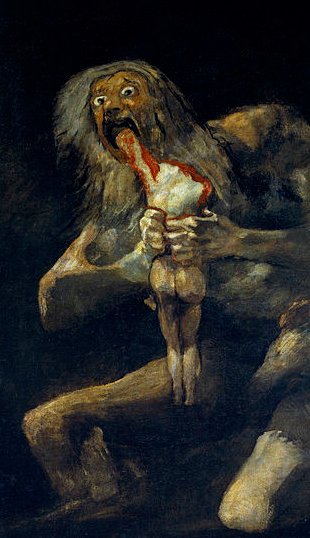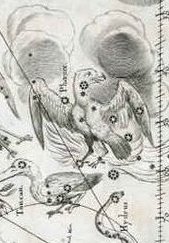From Gb3-11 at the end of the Pegasus
Square (Al Fargh al Thāni) to the
similar glyph Gb3-24
(where 3 * 24 = 72 could allude to glyph
72) there
were 13 days. And the preceding peculiar
Gb3-9 could be there in order to qualify
and explain the nature of the pregnant
vaha mea fish at day 378 (the
synodic cycle of Saturn).

Gb3-9
seems to exhibit a gaping mouth oriented
forward, a kind of devouring
mouth with 9 teeth ready for its task:
...
Finally, the South Building has 9
exterior doorways (the Underworld or
Xibalba
had 9 layers), and has the lowest
placement in the compex; it thus seems
to be associated with death and the
nether regions ...
 |
 |
 |
|
 |
 |
 |
|
Gb3-11 (72) |
Gb3-12 |
Gb3-13 |
Gb3-14 |
Gb3-15 |
Gb3-16 (306) |
|
JANUARY 16 |
17 |
18 |
19 (384) |
20 |
21 |
|
Al
Fargh al Thāni-25 |
Uttara Bhādrapadā-27
/
Wall-14 |
χ Pegasi (2.1), θ Andromedae
(2.7) |
σ Andromedae (3.0), ζ
Tucanae (3.5), ρ Andromedae,
π Tucanae (3.7) |
no star listed (4) |
Ankaa, κ Phoenicis
(5.0)
Alphard
|
|
0h (365.25) |
|
Caph,
SIRRAH
(0.5), ε Phoenicis (0.8) |
ALGENIB
PEGASI
(1.8) |
|
March 21 (0h) |
22 |
23 |
24 |
Equinox (84) |
26 (450) |
|
°March 17 (*361) |
18 |
19 |
20 |
21 (0h) |
22 |
|
'February 22 |
Terminalia |
Bissextum |
25 (*341) |
26 (422) |
27 (58) |
|
"February 8 |
9 (40) |
10 (*326) |
11 |
12 (408) |
13 |
|
NAKSHATRA DATES: |
|
JULY 18 |
19 (200) |
20 (*121) |
|
21 |
22-7 |
23 |
|
Alchita, Ma Wei
(183.1),
Minkar
(183.7), ρ Centauri (183.9) |
Pálida (184.6), Megrez
(184.9) |
Hasta-13 /
Chariot-28 |
Chang
Sha (186.3) |
Intrometida (187.4),
Acrux
(187.5) |
γ Com. Berenicis (188.0), σ
Centauri (188.1),
Algorab (188.5),
Gacrux (188.7)
|
|
GIENAH
(185.1), ε Muscae (185.2), ζ
Crucis (185.4),
Zaniah
(185.9) |
|
September 20 |
21 |
Equinox (265) |
23 |
24 |
25 |
|
°September 16 |
17 (*182) |
18 |
19 |
20 |
21 (*184) |
|
'August 24 (236) |
25 (*157) |
26 |
27 |
28 |
29 |
|
"August 10 (222) |
11 |
12 (*144) |
13 |
14 |
15 |
|
7 |
 |
 |
 |
|
Gb3-24 |
Gb3-25 |
Gb3-26 (87) |
|
JANUARY
29 (*314) |
30 |
31 (396) |
|
no star listed (13) |
no star listed (14) |
1h (15.2) |
|
β Phoenicis (15.1),
υ Phoenicis, ι
Tucanae (15.6), ζ
Phoenicis (15.7) |
|
April
3 |
4 |
5 (460) |
|
'March
7 (*351) |
8 |
9 (68) |
|
"February
21 (52) |
22 (418) |
Terminalia |
|
NAKSHATRA DATES: |
|
JULY
31 (*132) |
AUGUST 1 |
2 (214) |
|
δ Muscae (196.5),
Vindemiatrix (196.8) |
13h (197.8) |
Apami-Atsa, ψ Hydrae
(198.5) |
|
ξš Centauri (197.1),
ξ˛ Centauri (197.9) |
|
October
3 |
4 (277) |
5 |
|
'September 6 |
7 (250) |
8 (*171) |
|
"August
23 |
24 (236) |
25 (*157) |
Saturn ruled over the
wheel of time as Kronos (Chronos):

|
Egyptian bread, (-t,
female determinant) |
 |
Phoenician qoph |
 |
Greek
phi |
Φ(φ) |
|
... is the
21st letter of the Greek
alphabet ... Its origin is
uncertain but it may be that
phi originated as the letter
qoppa ... In traditional
Greek numerals, phi has a
value of 500 or 500000 ...
Isaac Taylor,
History of the Alphabet:
Semitic Alphabets, Part 1,
2003: 'The old explanation,
which has again been revived
by Halévy, is that it
denotes an 'ape,' the
character Q being
taken to represent an ape
with its tail hanging down.
It may also be referred to a
Talmudic root which would
signify an 'aperture' of
some kind, as the 'eye of a
needle,' ... Lenormant
adopts the more usual
explanation that the word
means a 'knot' ...
... The king, wearing now a
short, stiff archaic mantle,
walks in a grave and stately
manner to the sanctuary of
the wolf-god Upwaut,
the 'Opener of the Way',
where he anoints the sacred
standard and, preceded by
this, marches to the palace
chapel, into which he
disappears. A period of time
elapses during which the
pharaoh is no longer
manifest.

When he reappears he is
clothed as in the Narmer
palette, wearing the kilt
with Hathor belt and
bull's tail attatched. In
his right hand he holds the
flail scepter and in his
left, instead of the usual
crook of the Good Shepherd,
an object resembling a small
scroll, called the Will, the
House Document, or Secret of
the Two Partners, which he
exhibits in triumph,
proclaiming to all in
attendance that it was given
him by his dead father
Osiris, in the presence
of the earth-god Geb.
'I have run', he cries,
'holding the Secret of the
Two Partners, the Will that
my father has given me
before Geb. I have
passed through the land and
touched the four sides of
it. I traverse it as I
desire.' ... |
Obviously the reason
for the similarity between Gb3-11 and
Gb3-24 was time. There were 16 days
from the 1st to the 2nd spout, which
implies the beginning of the Pegasus
Square became visible again when the
Sun reached the end of the Square:
 |
 |
 |
 |
 |
14 |
 |
|
Gb2-27 |
Gb2-28 (54) |
Gb2-29 |
Gb2-30 (285) |
Gb2-31 |
Gb3-11 (72) |
|
DECEMBER 28 |
29 |
30 (364) |
31 |
JANUARY 1 |
16 |
|
ι Cephei (346.0), λ
Aquarii, γ Piscis
Austrini, σ Pegasi
(346.5) |
Scheat Aquarii (347.0),
ρ Pegasi (347.2), δ
Piscis Austrini (347.4),
Fomalhaut,
τ Gruis (347.8) |
Fum al Samakah (348.3),
ζ Gruis (348.5), ο
Andromedae (348.9) |
Al Fargh al Mukdim-24 /
Purva Bhādrapadā-26 /
House-13 |
23h (350.0) |
Al
Fargh al Thāni-25 |
|
0h (365.25) |
|
Scheat
Pegasi,
π Piscis Austrini
(349.3), κ Gruis
(349.4),
MARKAB
PEGASI
(349.5) |
υ, θ Gruis (350.0), π
Cephei (350.6), ι Gruis
(350.9) |
Caph,
SIRRAH
(0.5),
ε Phoenicis
(0.8) |
|
March 2 |
3 |
4 (428) |
5 (64) |
6 |
March 21 |
|
20 |
Number 20 appears
to have been
used both at
vaha mea in Gb2-28 and at
vaha mea in Gb3-8:
 |
 |
 |
 |
13 |
 |
 |
 |
|
Gb3-7 |
Gb3-8 |
Gb3-9 |
Gb3-10 (71) |
Gb3-24 |
Gb3-25 |
Gb3-26 (87) |
|
JANUARY
12 |
13 (378) |
14 |
15 (*300) |
29 (*314) |
30 |
31 |
|
φ Pegasi
(361.7) |
Dzaneb
(362.4) |
η Tucanae (363.0),
ψ Pegasi
(363.1), 32 Piscium (363.2), π
Phoenicis (363.4), ε Tucanae
(363.6), τ Phoenicis (363.9) |
no star listed (364) |
no star listed (13) |
no star listed (14) |
1h (15.2) |
|
β Phoenicis
(15.1),
υ Phoenicis,
ι Tucanae (15.6),
ζ Phoenicis
(15.7) |
|
20 |
In the former
case 0h - determined from
the position of 'Father Light' (Sun
as Jupiter) and at the time
of rongorongo - could have
been the decisive factor. In
the latter case the time of
the Hyades Gate and 314 days
after 0h could possibly have been the
reason.
16 days after
day 364 counted from March
21 there was - according to
my list - no important star
reappearing after having
been close to the Sun in
March 20 (Gb3-10). But the Phoenix
began to rise with the Sun
at 0h and
its first star ε should
therefore
return to view in April 6,
i.e. 96 - 80 = 16 days
later:

|
jubilation |
 |
Phoenician
he |
 |
Greek
epsilon |
Ε (ε) |
|
Wikipedia
points at
the Egyptian
gesture with
arms held
high as a
Sign of
jubilation,
which may
have been
the origin
(via
Phoenician
he)
of epsilon.

 |
|















